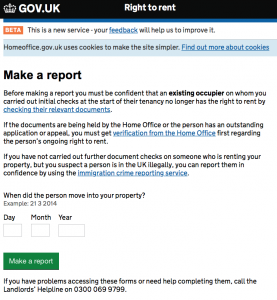There still appears to be much confusion about the penalties and expectations placed upon landlords (or agents acting on their behalf). In this article I will highlight the new penalties now in force, along with the key issues and areas of contention.
Criminal penalties now in place
Until now, failure to comply with Immigration Act 2014 guidelines could only lead to civil penalties for landlords. As of 1st December 2016 the Immigration Act 2016 enforcement measures are now live, meaning that non-compliance is also a criminal offence that can lead to 5 years imprisonment. It’s important to note that the latter is only likely to be imposed on repeat offenders intentionally floating the law.
One of the most alarming areas of confusion seems to lie within the fact landlords must check all occupants over the age of 18 and that they don’t have to be named on the tenancy agreement. In addition, many don’t realise that the civil penalties are based upon each illegal migrant being housed. For example, if a landlord had two tenants named on the agreement, but four occupants over 18 and it transpired they had failed to carry out the relevant right to rent checks – thus leading to illegal migrants being housed, their fine would look like this:
Occupant one – fine of £1,000
Occupant two – fine of £3,000
Occupant three – fine of £3,000
Occupant four – fine of £3,000
Total – £10,000
The civil penalties imposed are based upon the circumstances surrounding the breach. More information on this can found under section 7 in the GOV.UK right to rent guidance. For example, fines for private lodgers are less than above and there is also a discount if the fines are paid within a 21 day period.
Home Office can now evict tenants
In addition to imposing civil and criminal penalties, the Home Office will now also have the power to provide landlords with notices to end tenancies. Specific guidance on ‘Ending a tenancy due to immigration status‘ has been released. In addition to ‘Guidance on taking reasonable steps to end a residential tenancy agreement within a reasonable time‘. Here’s a brief summary of the latter:
What is taking reasonable steps to end a tenancy?
There are three key approaches to this:
(1) Mutual agreement with the tenant, whereby the tenant(s) agree to surrender the tenancy. Ideally in writing, where possible.
(2) Serving notice upon the tenant with usual procedure for that tenancy. Usually a Section 21 or Section 8 with an Assured Short Hold Tenancy. Please note: Section 8 forms have been updated on landlord association websites like RLA or letting agency governing bodies like ARLA to reflect changes brought in by the Immigration Act 2016.
(3) Eviction routes for disqualified people in England (Right to Rent is specific to England only) available on the gov.uk website ‘Evicting Tenants‘.
What is reasonable time?
This is definitely on a case-by-case scenario. First off, no action should be taken until it has been confirmed the occupant is a disqualified person. Here’s an excerpt that identifies the notice period:
“Where the Home Office has issued a notice explaining to a landlord that they are letting to a disqualified person, the landlord will be taken to know that they are letting to a disqualified person upon the notice being served. If the notice is not served in person, but by post or email, it will be deemed to be served two days after the date of the letter.”
New – report occupants without the ‘Right to Rent’ via the gov.uk ‘Eform’
From the 1st December 2016 there is now an online form that must be used in the first instance if the checks you perform identify the tenant does not have the ‘Right to Rent’. You can access this form here.

Important cross-overs with ‘Data Protection Act 1998’ and ‘Equality Act 2010’
Although Right to Rent is specific to the Immigration Act 2016, it’s very important to consider that there are cross-overs with other legislation and it’s crucial to consider your approach to carrying out these checks. Failure to do so may lead to breaches in data protection or even discrimination (direct or indirect).
From a right to rent perspective the guidelines are very specific when taking copies of documents. You must keep the document for a period of 12 months only after the tenancy has ended. However, from a data protection perspective it’s very subjective and open to interpretation. We contacted the Home Office and the Information Commissioners office on this and there are no specific requirements for the level of storage security. However, it was suggested that perhaps a secure filing cabinet in a locked building/office would suffice.
Moving onto the discrimination considerations, which is an important issue, because there are concerns that the complexities of Right to Rent will lead to Direct or Indirect discrimination. So what’s the difference?
Direct discrimination occurs when someone is treated less favourably because of their race, nationality or colour. For example, if properties are only offered to certain nationalities, or certain nationalities are excluded.
Indirect discrimination occurs where a provision, criterion or practice, although applied equally, would put persons of a particular racial group at a particular disadvantage compared with other persons. For example, if a requirement that a prospective occupant has been a resident in the UK for over five years was to be imposed (because migrants are less likely to be able to meet such a requirement than a UK citizen in most circumstances).
As demonstrated above, it’s not just about being consistent in your approach, because whether intentional or not, that could lead to consistent discrimination. It is, however, more important to be consistently compliant.
Stay consistent, compliant and paperless
Inventory Hive consistently takes you through each stage of the right to rent process, informing you about what documents are acceptable based on the residency status of your prospective occupants. Furthermore, it provides a clear audit trail of the visual checks you made upon the documents provided by the occupants. This enables you to provide a statutory excuse in the event of a convincing fraudulent document being supplied.
- No more copying and filing – Use your phone or tablet camera to directly upload electronic copies of documents with secure password protected cloud storage. Complies with Data Protection Act 1998 to avoid the need for secure filing cabinets, or even alarms and CCTV.
- Stay organised – Receive emailed reminders to re-check tenants with ‘Time Limited’ Right to Rent documents. Complies with Immigration Act 2016.
- Fair checks – Follow our step-by-step guidance and avoid discriminating against legitimate tenants. Fairly checking all tenants equally and consistently. Complies with Equality Act 2010.
- Show compliance – Based on the nationality or citizenship of occupants you are informed what documents are acceptable along with what steps to follow when visually checking the documents. Complies with Home Office Immigration Act 2016 guidance.

A 30 day free trial (no card details required) of Inventory Hive can be accessed here (just choose ‘Get Started’). As the name suggests, it’s also an easy to use platform for creating industry compliant: inventories; check-in; inspection and; check-out reports.
